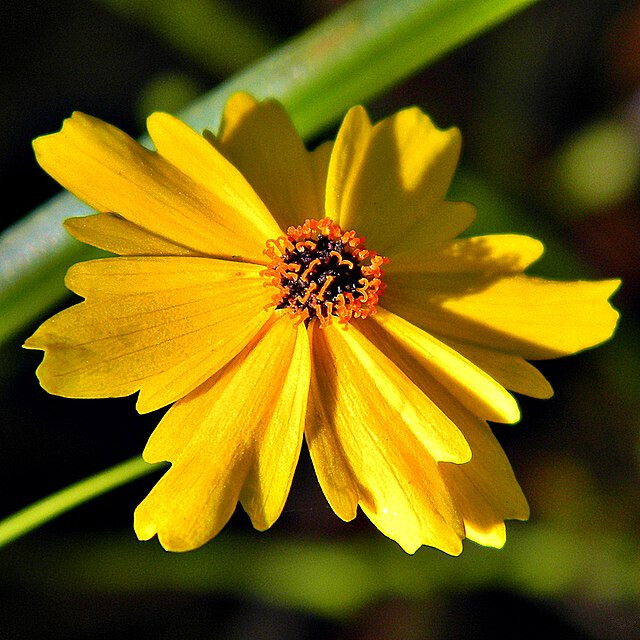Written by Don Richardson

 Tickseed (Coreopsis Leavenworthii)
Tickseed (Coreopsis Leavenworthii)Plant Type | Annual Wildflower |
Size | 1-3’ tall, 0.5-1.5” wide |
Sun Exposure | Full sun, part sun |
Soil Type | Clay, loam, sand |
Soil pH | 5.6 – 7.7 Acidic - Neutral |
Bloom Time | All year |
Hardiness Zones | 8a-11b State Wildflower |
Moisture | Moist - dry, Well drained |
Cold/Heat | 10°F – Is drought tolerant |
Pollination | Self-pollinates, self-seeds |
Edible Plant | No, but leaves for tea |
Medicinal Plant | Yes |
Any reference to medicinal or culinary use of plants or plant parts should in no way be considered an endorsement by The Ocala Food Forest or its staff. Research is crucial in safe and proper consumption or experimentational use of any plant.
Coreopsis Leavenworthii is a flowering plant native to North America. It belongs to the family Asteraceae, which includes daisies and sunflowers. This plant is commonly referred to as “Leavenworth’s Tickseed” and has many characteristics that make it a favorite of gardeners and nature lovers alike. Let’s take a look at this unique flower.
Description of the Plant
Coreopsis Leavenworthii is an herbaceous perennial plant that grows between one and two feet tall in full sun or partial shade. The leaves are lance-shaped and have toothed edges, while the flowers are small with yellow petals and brown centers. The flowers bloom from late spring through early summer, making them great for adding color to your garden during these months.
Habitat & Growing Conditions
Coreopsis Leavenworthii is found in grassy areas such as prairies, meadows, roadsides, and parks throughout much of the United States. It prefers full sun but will tolerate some shade, making it an ideal choice for gardens with partial sun exposure. The soil should be well-drained and slightly acidic; sandy soils are best for growing this species of tickseed.
It is important to note that Coreopsis Leavenworthii does not actually like direct sunlight all day long; too much sunlight can cause leaf scorch or wilting of the leaves due to drought stress. To prevent this from occurring, water plants regularly during hot summer months; mulching around plants can also help conserve moisture in the soil. Additionally, deadheading spent blooms will encourage more flowers to form throughout the season.
Uses & Benefits
This versatile flower has many uses in both gardens and wild spaces. It can be used as a ground cover or filler plant in gardens, as it will spread quickly without taking over a space completely. It is an excellent choice for landscaping projects due to its tolerance of various soil types and light levels; it also attracts bees and butterflies to your garden with its colorful blooms! so planting Coreopsis Leavenworthii in natural areas can help attract wildlife into your yard or garden. It also makes for a great cut flower when harvested at peak bloom! Furthermore, it is easy to propagate by division or seed collecting; simply collect seeds when they have ripened on the plant (usually in late summer/early fall), then sow them directly into your garden or start them indoors 4 weeks before your last frost date. Finally, it makes an attractive cut flower—simply snip off stems at their base when they are just beginning to show color!
Conclusion:
Coreopsis Leavenworthii is an easy-to-grow perennial that will add beauty to any garden or natural area with its vibrant yellow flowers. This low-maintenance flower requires little effort on your part aside from regular watering and fertilizing, but will reward you with months of flowering each year without fail! Whether planted en masse or used as an accent piece among other plants, this versatile little flower will bring life into any outdoor space — no matter how small! For those looking for an attractive yet low-maintenance addition to their landscape, Coreopsis Leavenworthii should definitely be considered!
Coreopsis Leavenworthii is an easy-to-grow perennial that will add beauty to any garden or natural area with its vibrant yellow flowers. This low-maintenance flower requires little effort on your part aside from regular watering and fertilizing, but will reward you with months of flowering each year without fail! Whether planted en masse or used as an accent piece among other plants, this versatile little flower will bring life into any outdoor space — no matter how small! For those looking for an attractive yet low-maintenance addition to their landscape, Coreopsis Leavenworthii should definitely be considered!










0 Comments